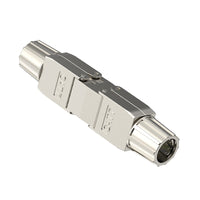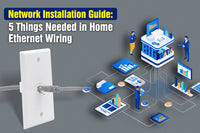Network cabling can be complicated when people know little about network installation. Improper network installation can cause many network errors, making you feel frustrated. Consider the following factors when running an Ethernet cable, and this article will teach you some tips for installing and maintaining network cables.
Know About Your Cable Installation Environment
- If your installation environment is exposed to high RFI (Radio Frequency Interference) and EMI (Electromagnetic Interference), you must use a shielded Ethernet cable instead of an unshielded one. In addition, place the cable away from high-voltage equipment as it will affect the network speed. When you choose to use a shielded network cable, you’d better use it with shielded keystone jacks or RJ45 connectors for the best performance.
- Before running an Ethernet cable, you’d better make a simple floor plan for your house or office, which can help visualize your wired connection. Take the bend radius, distance, and turns of your Ethernet cable into account for a suitable cable length. Remember to add some inches to the accurate measurement.
- Do you want to install the Ethernet cable indoors or outdoors? Will you run the Ethernet cable in the HVAC systems or other safe locations? The cable jacket comes in different ratings, including CMP, CMR, CATVP, CL3R, CMX, etc. And it would be best if you chose different cable jackets for different scenarios. For example, CMX cables are used for outdoor applications, and Plenum Rated Cable (CMP) cables must be used for HVAC systems.
Learn About Ethernet Cable Categories in Advance
Selecting the correct category of Ethernet cable for your home or office network is essential. It is known that Ethernet cables can be divided into various categories, including CAT5, CAT5E, CAT6, CAT6A, CAT7, and CAT8, among which CAT8 is the latest version. (Know more about Ethernet cables from this blog.) In general, CAT6 cables are enough for most homes and small businesses. CAT6A, CAT7 or CAT8 cables are often used in data centers or server rooms. However, it all depends on your need for network speed. Before running Ethernet cables, you need to have a research on the maximum speed of different Ethernet cables.

Learn How to Use Network Tools
Tools needed in network installation
- RJ45 Crimping Tool: This tool combines the function of crimping and cutting, used to terminate RJ45 connectors. The pass-through crimping tool is paired with pass-thru RJ45 connectors, which is more recommended for novices as it increases the success rate of termination.
- Wire Stripper: The wire stripper is not a must-have tool in network installation, but they really help you remove and strip the cable jacket accurately and quickly.
- Punch Down Tool: The most often used types are Krone and 110 punch-down tools, suitable for punch-down patch panels and keystone jacks.
- Wire Cutters/Flush Cutters: The flush cutter is a helpful tool in network installation, which helps easily cut off copper wires.
- RJ45 Tester: A network tester is necessary in network installation as it can help you quickly find network problems. You can learn how to use it before the network project.
Other Network Accessories
- Ethernet Wall Plate: Ethernet wall plates are essential if you want to run the cable in different rooms. They help organize cables for a clean look.
- Patch Panel: Patch panels are often used to make your cabling system centralized in a place, making the network easy to upgrade. They are usually attached to the wall or in the network cabinet.
- Server Rack: The server rack is usually used in data centers or server rooms for easy cable management.
Plan for the Future
As the Ethernet technology advances with time, the current technology may not meet your needs, and you need to replace your Ethernet cable for better performance. It will be a complex thing to upgrade your network. Why not choose a future-proof cabling plan? Always remember to use a higher-rated cable that can not only satisfy your current needs but also prove your future needs. In addition, it is recommended to opt for a network switch or router with more ports so that you can add other devices in the future.
Do’s and Don’ts When Running Ethernet Cable
- Do: Follow the wiring diagram
Ethernet cables features 8 copper wires twisted into 4 pairs, and you should follow T568A or T568B wiring standards to ensure stable data transmission between devices. Using the same wiring standard on both ends is crucial, or you’ll get a crossover cable, which is typically used for connecting similar devices.
- Do: Use cable management
Cable spaghetti can be a disaster, and you must don’t want to see that happen in your home or office. Cable management is very essential as more cables will be added to your cabling system. And it can also make your cable maintenance easier. You’d better label cables and color-code them so that you can identify them.
- Do: Take the distance limitation into account
The typical maximum distance of Ethernet cables is 100 meters or 328 feet. But things can be different for some categories of Ethernet cables. For example, if you want to achieve 10 Gbps within 100 meters, choose CAT6A or higher category cable.
- Do: Complete proper network test
If you have installed your cable, the last thing to ensure that your cable can work well is to test the cable. You can use a standard RJ45 or more professional tester to see if your cable can work well and reach your desired speed.
- Do: Protect cables from damage and replace damaged cables
Ethernet cables can be broken with physical damage, such as bends, cuts, and abrasions. Avoid running Ethernet cables around heavy objects. Moreover, Ethernet cables may not work over time, and you should monitor your network performance carefully to find problems in time. If you find any cable issues, replace the cable as soon as possible for perfect cable performance.
- Don’t: Bundle cables tightly
Bear in mind that don’t bundle cables tightly during the network installation. Too much bending and curling will affect the quality and performance of the Ethernet cable.
- Don’t: Install the cable near a “noisy” place
It is suggested that the Ethernet cable cannot be placed near other electrical cables as it will increase the chance of interference and affect the data transmission. Avoid planning your cabling near high-voltage devices and electrical cables.
For more information on this topic, you can keep up on our blogs. While VCELINK offers general and basic information for our customers and other visitors to the website, it’s not professional advice.




Be the first one to comment.
Leave a comment